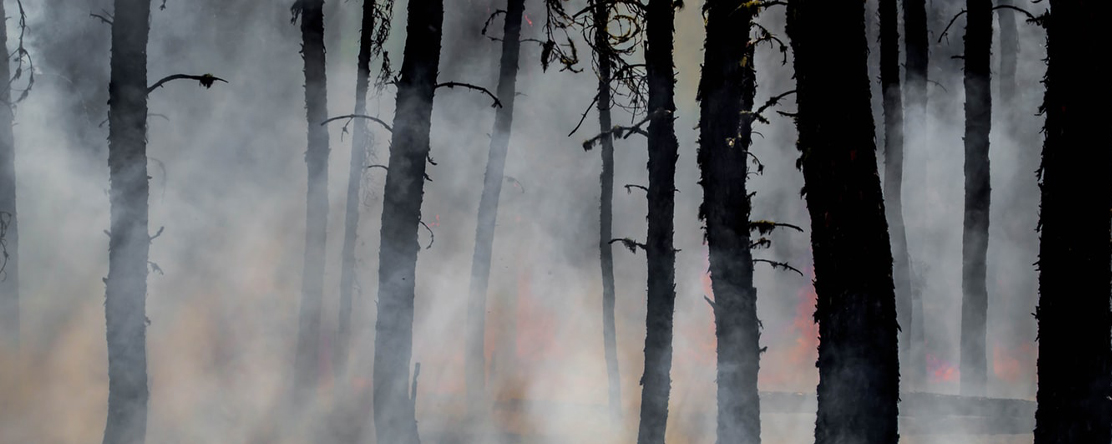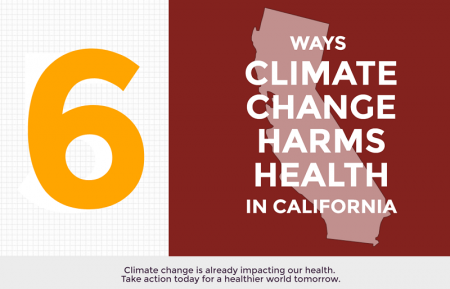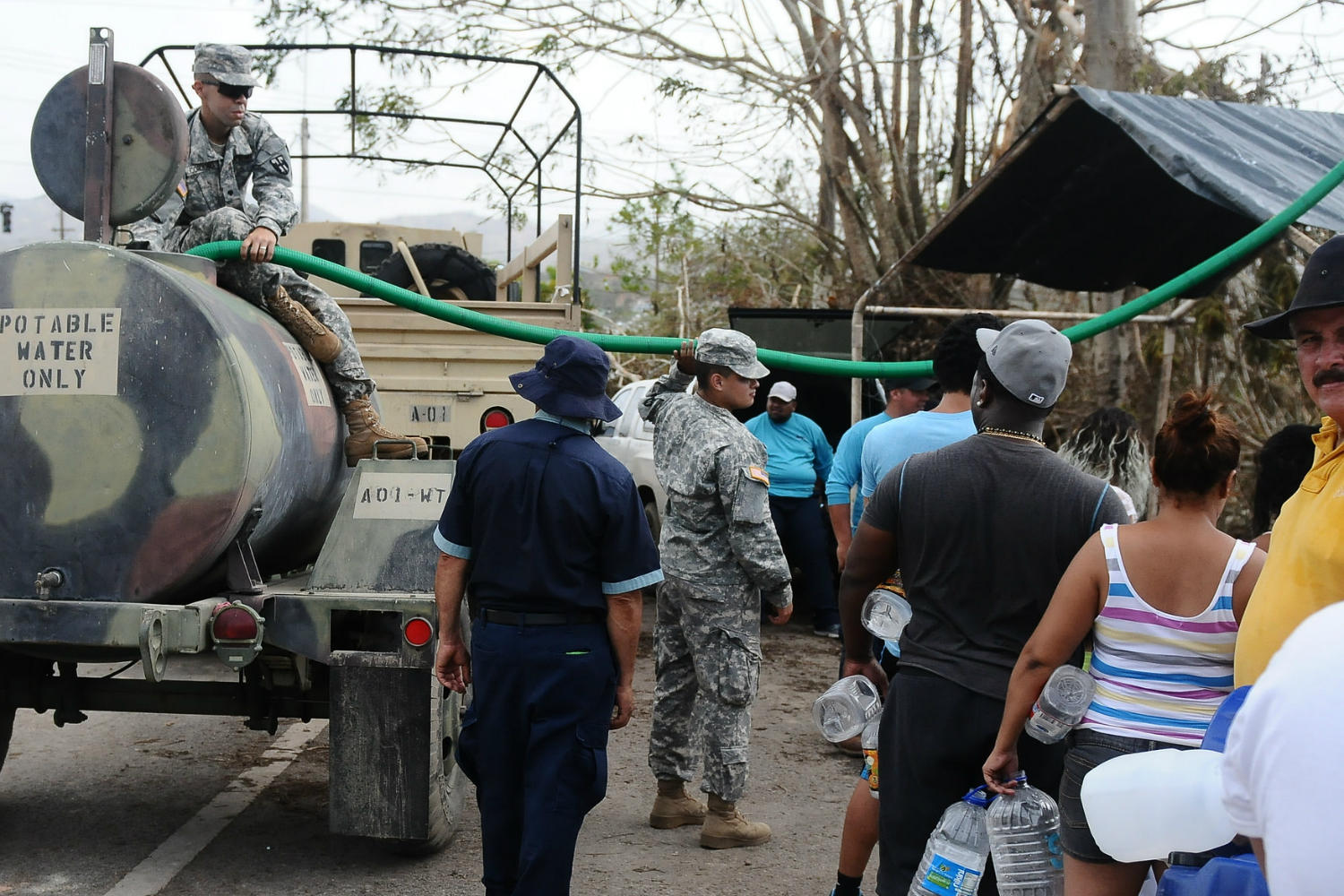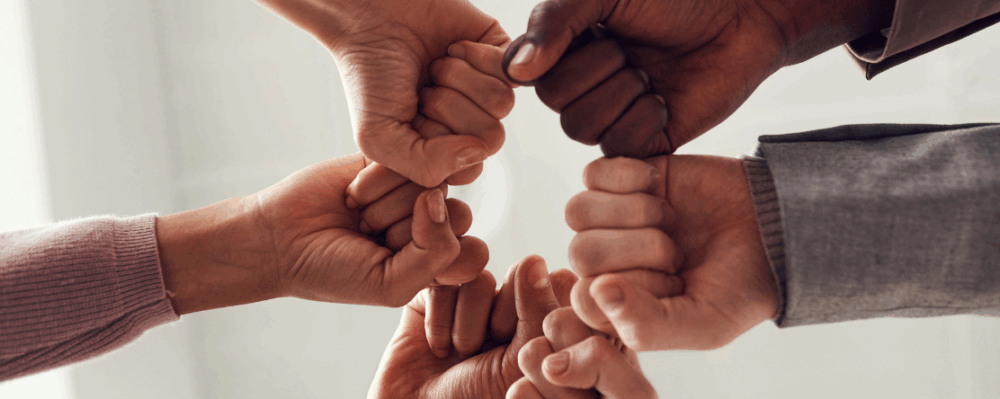
Update
Climate Change is Making Natural Disasters Worse, and More Likely. How Do We Protect the Most Vulnerable?
- Jennifer Scroggins
-
Focus Areas
Environmental Health -
Issues
Climate Change -
Programs
Center for Climate Change and Health, Pacific ADA Center

 Aerial images show the Coffey Park neighborhood in Santa Rosa before and after the wildfires. (Image: CNN) |
In the early morning hours of October 9th, residents of California’s wine country woke to a terrifying reality. Unimaginable heat bore down from a firestorm moving so quickly that many of those who survived did so with only the clothes they were wearing.
More than 245,000 acres burned during the state’s most disastrous wildfire, displacing 100,000 residents, blanketing the entire region in plumes of hazardous smoke, and killing at least 43 people.
On the other side of the country, Puerto Ricans are reeling from the devastation wrought by Hurricane Maria. The storm has destroyed the island’s health infrastructure, caused the longest blackout in U.S. history, and killed at least 51 people (though there is speculation that the number of deaths may actually be higher).
And back on the mainland, Houston and surrounding areas are rebuilding and dealing with the toxic aftermath of the catastrophic flooding and subsequent air pollution caused by Hurricane Harvey, one of the nation’s most destructive natural disasters to date, which killed at least 82 people.
The immediate links between these three historic disasters and climate change are evident, as are the impacts they have on lives and communities. But what is less discussed are the devastating health impacts connected to these events, some of which will linger for years to come. As with the natural disasters themselves, the impacts are greatest among those who are most vulnerable.
“The recent hurricanes and California’s tragic fires are another demonstration of the fact that climate change is already threatening our health and safety,” says Linda Rudolph, MD, MPH, director of the Public Health Institute’s Center for Climate Change and Health in Oakland, CA. “And these incidents are only going to get worse if we don’t act now.”
Climate Change’s Role
To a certain extent, disasters like firestorms and hurricanes are an unavoidable part of life on Earth—scientists do not believe they are a direct result of climate change. But a warming planet does create the conditions that make these extreme weather events more likely, and more severe.
“Just in the last month, we’ve seen the profound impact of hurricanes fueled by warm water temperatures and wildfires fueled by warm temperatures,” Rudolph said during a press briefing last month about our increasing number of extreme heat days. “If we keep pouring climate pollutants into the atmosphere, we will face a level of global warming in which our best efforts will be inadequate to prevent the adverse impacts of heat on our health.”

Human-made carbon pollution has driven up the global average temperature for more than a century
Greenhouse gas emissions have driven the global average temperature higher for more than a century. Three years ago, 2014 set the record for hottest year ever recorded; temperatures the next year soared significantly above those levels, and again in 2016.
“Climate change has introduced unprecedented rates of change for anything that we’ve been able to measure or recreate,” says LeRoy Westerling, Professor of Management of Complex Systems and Co-Director of the Center for Climate Communication at UC-Merced.
“You have two dials: one controls how much precipitation is going in, and that’s getting more variable and maybe slightly increasing over time on average,” Westerling explains. “And the other is the temperature, and that’s mostly going in one direction—it’s getting warmer—and that’s increasing the evaporation coming out.”
This means a drying landscape with more flammable fuel—increasing the odds of disastrous firestorms and droughts, even in some areas that haven’t historically been fire-prone.
“We’re seeing Northern California, as it dries out, is acting more like Southern California. It’s becoming more and more common here that we’re having fire weather,” explains Bill Stewart, Co-Director of the UC Berkeley Center for Forestry and Center for Fire Research and Outreach. “It seems like we’re living in a county that’s one or two counties south every decade in terms of fire behavior.”
Burning of fossil fuels has also created higher water temperatures and a warmer atmosphere, which most scientists agree are linked to stronger and more dangerous storm systems like the devastating hurricanes in the Caribbean and Gulf of Mexico this fall.
Severe tropical storms and strong hurricanes will be both more common and more intense in the near future. Warmer air holds more water vapor, which leads to more rain—like the historic rainfall we saw during Hurricane Harvey. This also means more intense storm surges, which will come on top of already rising sea levels.
The Impacts on Our Health
Beyond the deaths and injuries they bring in the short term, more frequent and intense weather events have lingering impacts that threaten the basic life support systems upon which we rely—clean air, water, food, shelter, and security.
 Learn how climate change is already contributing to California’s rising rates of disease, poverty, and death—and how you can take action—in this infographic Learn how climate change is already contributing to California’s rising rates of disease, poverty, and death—and how you can take action—in this infographic |
Smoke from wildfires, which can travel thousands of miles, is associated with increased premature deaths, hospitalizations for respiratory diseases and worsening heart disease. Ash and debris from burned homes and buildings expose people to toxic chemicals like asbestos and heavy metals.
Flooding can cause contamination of drinking water supplies with untreated sewage or chemicals, and can also increase waterborne diseases as warmer air and water temperatures cause higher levels of microbial contamination. Storms and flooding can also wipe out crop production, leading to higher food insecurity and costing low-income farm workers their livelihood.
Rudolph, a medical doctor by training, works to draw connections between climate change and the impacts on human health and well-being like these that may not always be obvious.
“The risks of mental health problems, especially depression and post-traumatic stress disorder, after a catastrophic event are also high and often not discussed as much,” she says, noting that rates of anxiety disorders and suicide are expected to rise as the effects of climate change worsen.
“Our current mental health system is woefully underprepared to deal with the scale and intensity of problems climate change is expected to bring.”
The Health Equity Implications
Children, low-income populations, people of color, the elderly and others with low mobility are some of the groups most vulnerable to climate change-related severe weather events and their accompanying health impacts. They are the least able to evacuate during a disaster, and least able to relocate or protect themselves from the impacts afterward.
If you are a person of color, or living in poverty, you are already more likely to lack access to clean water and to have chronic exposure to air pollutants linked to asthma, cardiovascular problems, lung disease, and cancer. Hazardous waste sites and chemical facilities are more likely to be located in your community, increasing your risk for exposure to toxic substances in the event of catastrophic accidents at these sites, such as floods or earthquakes.
In Houston’s low-income areas, families already facing the chronic health issues associated with living near the region’s huge refineries and chemical plants have now been exposed to dangerously high levels of dioxins, benzene and other toxic chemicals that leaked from flooded oil and gas industry sites in the wake of Hurricane Harvey.
Accidents and shutdowns in the area spewed about 2.6 million pounds of pollutants into the air.
In the predominantly Latino Manchester neighborhood, where residents are at least 24% more likely than people in wealthy Houston neighborhoods to develop cancer or respiratory illnesses, levels of the carcinogen benzene were detected at nearly double the state’s allowable level a full eight days after a roof collapsed at the nearby Valero Energy refinery. It’s unclear what the levels may have been earlier, as air monitors were shut down during the storm.
Many of the victims of the wildfires in California were seniors and their caretakers, who were unable to flee as the flames—fanned by strong winds—spread faster than emergency responders could initially get in front of them to warn people. Now, as the smoke lifts, it’s those without financial means and those without documentation who are left wondering how they will rebuild and make ends meet.
It has been widely reported that in both California and the Houston area, federal disaster aid will not be offered to undocumented residents, and deportation and detention policies deter others from seeking help from other sources, or from accessing health care. Unauthorized vineyard workers in California’s wine country have either lost jobs or vital paychecks but can’t apply for funds to help cover their lost wages.
At a time when California is experiencing a serious shortage of affordable housing, Christopher Thornberg of Beacon Economics in Los Angeles also estimates that the fires wiped out 3% of the area’s housing stock, leaving lower income renters in particular with few options.

The Puerto Rican National Guard distributing water to residents following Hurricane Maria (Photo: Puerto Rico National Guard/Flickr/cc) |
In Puerto Rico, the wipeout of the island’s fragile power grid is massively slowing down relief efforts and has proven deadly for some elderly and sick individuals, who relied on electricity to power oxygen tanks, dialysis equipment and other critical apparatus.
Electricity is also needed to power water systems. As of the writing of this story, nearly seven weeks after Hurricane Maria made landfall, millions of residents in Puerto Rico still had no access to drinking water. There have been several reports of people drinking potentially contaminated water, including from a Superfund site, either out of desperation or because they are unaware of the dangers, elevating the risk of waterborne illness outbreaks.
Gastroenteritis and conjunctivitis outbreaks have been reported, and officials fear the bacterial infection leptospirosis may be spreading, with three reported deaths and over 70 possible cases so far.
People living in the rural mountainous center of Puerto Rico, where Maria hit the hardest, are the ones who have been left without power the longest, as the government prioritizes restoring electricity in the capital of San Juan and other areas first. Officials estimate it may take six to eight months before power is fully restored on the island.
What Does Resilience Look Like?
There is much to do in these communities to help them recover, and the effects of the disasters will linger for years to come. But as climate-related crises become increasingly more likely, it is not enough to simply rebuild things the way they were.
Local officials must prioritize those who are hurt most by these disasters—engaging them directly in the recovery process, incorporating the specific needs of society’s most vulnerable groups in future disaster planning, and making communities healthier in the meantime.
“We cannot address climate change without addressing the fundamental social determinants of health,” explains Rudolph. These include factors like socioeconomic status, access to quality healthcare and education, a safe physical environment, employment opportunities, and social support networks.
“Communities with access to resources for health and with strong social ties will be more resilient in the face of disasters,” Rudolph says.
The same strategies that address health disparities can also mitigate climate change. For instance, curbing harmful diesel-truck pollution both protects against global warming and decreases asthma and other pollution-related health risks to millions of Americans who live and work in port regions.
 An abandoned wheelchair remained inside a school in a New Orleans suburb almost two years after Hurricane Katrina. PHI’s Pacific ADA Center provides guidance on including persons with disabilities in emergency plans. (Photo: J. Richards/AFP/Getty Images) |
Public health and community partners can take on climate change in ways that make a difference now and for future generations, but involving vulnerable populations themselves in these processes is critical.
As efforts shift to rebuilding after disasters, the local communities and the most at-risk individuals must be engaged in planning efforts. Priority should be given to hiring locally. This will boost local economies and provide income for resident workers, especially those who may lack the financial assets or access to federal aid needed to provide for their families.
Puerto Rico’s disastrous electricity and water crises have painfully illustrated that critical infrastructure systems must be built to withstand the extreme weather events of the future. Hospital and healthcare systems also have to be shored up to ensure they can continue to adequately provide medical care in the aftermath of these events.
The uneven recovery in New Orleans following Hurricane Katrina also reminds us that city officials need to prioritize assisting displaced residents from low-income communities and communities of color in returning home and rebuilding. Just 44% of displaced African Americans returned to New Orleans, compared to 67% of whites, who on the whole lived in higher income areas that were quickly rebuilt.
Often in the wake of a natural disaster, emergency management officials will understandably revisit their recovery plans, both in the affected areas and in other regions that live under similar threats, and ask whether anything should be adjusted or added.
If they weren’t already, those who are most at risk from climate-related disasters have to be incorporated in emergency preparedness plans. Disaster officials must anticipate and address underlying inequities in access, and ensure that agencies know how to reach and communicate with everyone, regardless of ability, age, income or language.
For the past five years, PHI’s Pacific ADA Center has hosted a series of webinars providing guidance on ways to include persons with disabilities in emergency preparedness and management plans. An invaluable resource to disaster officials and others involved in emergency planning, these sessions are all archived for viewing online.
Whatever strategies we undertake to reduce the harms that extreme climate-related weather events bring, they will be necessary but ultimately inadequate.
The only way to truly protect anyone long-term is to dramatically reduce our greenhouse gas emissions.
“We certainly need to prepare for the impacts of climate change,” says Rudolph. “But it’s critical that we act to reduce emissions of climate pollutants so that we prevent even more devastating climate change impacts on our health and the wellbeing of our communities and our children.”
More Updates
Work With Us
You change the world. We do the rest. Explore fiscal sponsorship at PHI.
Support Us
Together, we can accelerate our response to public health’s most critical issues.
Find Employment
Begin your career at the Public Health Institute.



